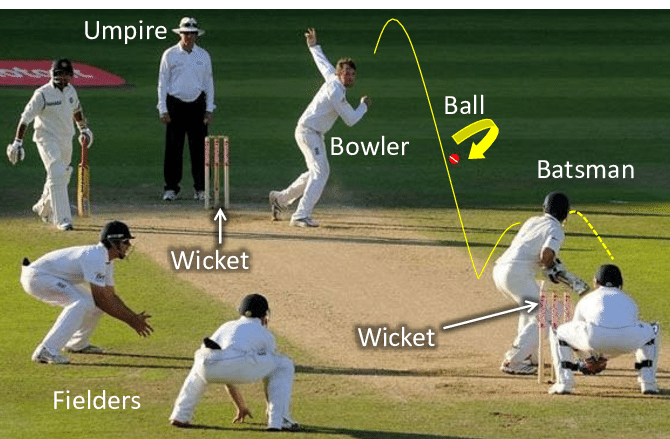The (virtual) physics of cricket
Tags: Virtual Reality, Physics, Cricket
Cricket is traditionally seen as a complicated game (see below), so how can it be simulated in virtual reality? Let's start by breaking the game down into parts...
Cricket: an overview
At any given moment during a game of cricket, there are two batters, ten fielders and a bowler (discounting the umpires for the purposes of this article!). Of the two batters, one is "on-strike" (facing the bowler), and one is "off-strike" (not facing the bowler), and while there are limits on where the fielders can stand, they all generally require the fielder to react and run to where the batter has hit the ball. The real beating heart of any cricket game is the interaction between the on-strike batter and the bowler.
 Source: Sheng Shen - Research Gate
Source: Sheng Shen - Research Gate
Batting and bowling in VR
Fortunately, while bowling isn't easily replicated VR (due to the movement and high ceilings required), batting is close to ideal - it's practically stationary, and it only requires tracking hand positions while holding a simple object (the cricket bat). While this sounds simple enough to simulate in VR, there are a lot of nuances here in order to make batting feel realistic which I'll elaborate on more in a future post.
Fielding in VR
What about simulating fielding in VR? It's possible, but as it requires a lot of running (and diving, if you watch any of the Big Bash highlights) around, it's likely to result in a nauseating experience currently. There are exceptions here that warrant further investigation, such as wicket-keeping practice, or other more stationary fielding positions, such as slips or close-in fielders. These positions rely more on fielder's reactions to catch the ball, and less on running and diving, and so could work well in VR.
So, we've determined that batting is the best place to start, but that we also need fielders and a bowler too. What now? Well, while we can't yet let a bowler bowl in virtual reality, we still need somebody to bowl! Here, we have two options: create an animated bowler, or a virtual bowling machine. While an well-animated bowler is the better choice, it's also much harder; also, studies show that batters learn to predict where the ball will land based on the bowler's pose as they bowl, so a poorly animated bowler is also both misleading and off-putting! Not wanting to make batting harder than it already is, Cover Drive Cricket uses a virtual bowling machine (for now).
 Source: The Opinion Wire
Source: The Opinion Wire
A virtual bowling machine
A firm favourite of many clubs around the world, a good bowling machine enables batters to get consistent, high-quality batting practice without the occasional wides that tired bowlers may let slip. If configured correctly, they can bowl pace, swing or spin, but setting the correct configuration can be an art in itself - thankfully, a virtual bowling machine is much easier! 5 numbers are all that's required to bowl any type of pace, swing or seam, landing exactly where required, to either left- or right-handed batters. (I'll also elaborate more on this in a future post.) No more tired or wayward net bowlers!
Everything else
Finally, now that we've got the batters, bowlers and fielders sorted, we just have to simulate the pitch conditions, the stumps, the stadium, the crowd, the fireworks, boundaries, scoring systems, replays and statistics... Quite a task, but absolutely worth it. There's nothing quite like the sensation of scoring a six in front of a packed crowd, while in your living room!
Thanks for reading! Any questions? Reach out to me at @coverdrivevr.
Addendum: A complicated game?
Is cricket really that complicated? Many people think so, stating that the Leg Before Wicket (LBW) laws in cricket is much more confusing than the off-side rule, for example. While every sport has its nuances, I believe that cricket is, at its core, relatively simple, which is what makes it so enjoyable to watch!
I leave you with this less-than-helpful description of the game though...
You have two sides, one out in the field and one in. Each man that's in the side that's in goes out, and when he's out he comes in and the next man goes in until he's out. When they are all out, the side that's out comes in and the side thats been in goes out and tries to get those coming in, out. Sometimes you get men still in and not out.
When a man goes out to go in, the men who are out try to get him out, and when he is out he goes in and the next man in goes out and goes in. There are two men called umpires who stay all out all the time and they decide when the men who are in are out.
When both sides have been in and all the men have out, and both sides have been out twice after all the men have been in, including those who are not out, that is the end of the game!
